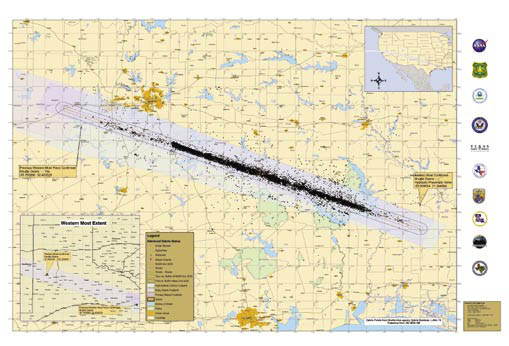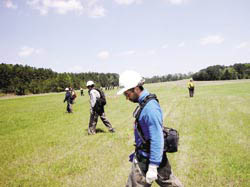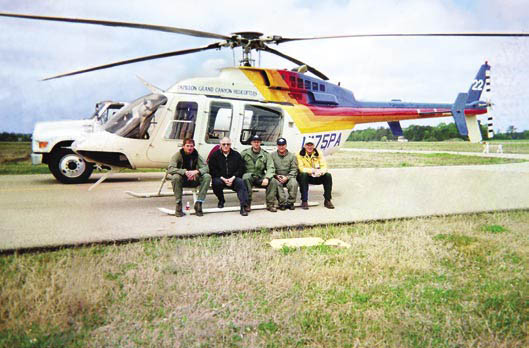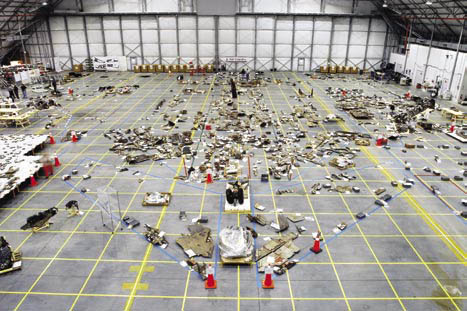2.7 EVENTS IMMEDIATELY FOLLOWING THE ACCIDENT
2.7 Events Immediately Following the Accident
A series of events occurred immediately after the accident that would set the stage for the subsequent investigation.
続く調査の舞台を用意すべく行われた、事故直後の一連の活動について。
NASA Emergency Response
NASAの緊急対応
Shortly after the scheduled landing time of 9:16 a.m. EST, NASA declared a "Shuttle Contingency" and executed the Contingency Action Plan that had been established after the Challenger accident. As part of that plan, NASA Ad-ministrator Sean OKeefe activated the International Space Station and Space Shuttle Mishap Interagency Investigation Board at 10:30 a.m. and named Admiral Harold W. Gehman Jr., U.S. Navy, retired, as its chair.
着陸予定時間の直後、東部標準時9:16AMには、NASAは「シャトルの緊急事態」を宣言し、チャレンジャー事故のときに設置された緊急時行動計画が実行に移されました。この計画の一環としてNASA長官シーン・オキーフは国際宇宙ステーション及びスペースシャトル事故組織間調査委員会を立ち上げ、アメリカ海軍退役のハロルド・ゲーマンJr司令長官を議長に任命しました。
Senior members of the NASA leadership met as part of the Headquarters Contingency Action Team and quickly notified astronaut families, the President, and members of Congress. President Bush telephoned Israeli Prime Minster Ariel Sha-ron to inform him of the loss of Columbia crew member Ilan Ramon, Israels first astronaut. Several hours later, President Bush addressed the nation, saying, "The Columbia is lost. There are no survivors."
NASAの幹部たちは、緊急時行動チームの本部メンバーとして宇宙飛行士の家族、大統領そして議会のメンバーに事故のことを伝えました。ブッシュ大統領はイスラエルのアリエル・シャロン大統領に電話をかけ、コロンビアの乗員だったイアン・ラモンー彼はイスラエル初の宇宙飛行士でしたーが亡くなったことを告げました。数時間後、ブッシュ大統領は国民に対してこう述べました。「コロンビアが失われました。生存者はいません」
In order to preserve all material relating to STS-107 as evidence for the accident investigation, NASA officials im-pounded data, software, hardware, and facilities at NASA and contractor sites in accordance with the pre-existing mishap response plan.
STSに関連したあらゆるものを事故調査の証拠として保存するために、あらかじめ定められた事故対応プランに従い、NASAの職員はデータ・ソフトウェア・ハードウェアそしてNASAと委託業者の施設を差し押さえました。
At the Johnson Space Center, the door to Mission Control was locked while personnel at the flight control consoles archived all original mission data. At the Kennedy Space Center, mission facilities and related hardware, including Launch Complex 39-A, were put under guard or stored in secure warehouses. Officials took similar actions at other key Shuttle facilities, including the Marshall Space Flight Center and the Michoud Assembly Facility.
ジョンソン宇宙センターでは、職員がフライトコントロールの制御宅からオリジナルのミッションデータを保存するまで、ミッションコントロールのドアに鍵かかけられました。ケネディ宇宙センターでは、39-A発射台を含むミッションに関連した施設とハードウェアが警備下に置かれ、また安全な倉庫に保管されました。マーシャル宇宙飛行センターや、ミショー組立工場などのシャトルの主要施設で同じような対応をとりました。
Within minutes of the accident, the NASA Mishap Inves-tigation Team was activated to coordinate debris recovery efforts with local, state, and federal agencies. The team initially operated out of Barksdale Air Force Base in Louisiana and soon after in Lufkin, Texas, and Carswell Field in Fort Worth, Texas.
事故後すぐに、NASAの事故調査チームは地方・州・連邦政府と協力して破片回収のための手配を始めました。チームはまず始めにバークスデイル空軍基地近郊から初め、テキサス州ラフキン、テキサス州フォートワースのカーツゥエル基地でも回収作業を始めました。
Debris Search and Recovery
破片の捜索と回収
On the morning of February 1, a crackling boom that sig-naled the breakup of Columbia startled residents of East Texas. The long, low-pitched rumble heard just before 8:00 a.m. Central Standard Time (CST) was generated by pieces of debris streaking into the upper atmosphere at nearly 12,000 miles per hour. Within minutes, that debris fell to the ground. Cattle stampeded in Eastern Nacogdo-ches County. A fisherman on Toledo Bend reservoir saw a piece splash down in the water, while a women driving near Lufkin almost lost control of her car when debris smacked her windshield. As 911 dispatchers across Texas were flooded with calls reporting sonic booms and smoking debris, emergency personnel soon realized that residents were encountering the remnants of the Orbiter that NASA had reported missing minutes before.
2月1日の朝、コロンビアの空中分解を示すパチパチという響きが東テキサスの住民たちを驚かせました。長く続く低いゴロゴロという音が、中央標準時8:00になる寸前に聞かれました。これは、破片が時速12,000マイルで上層大気に飛び込んだ時の音でした。そして、数分の後には破片が地上へと落ちてきました。東ナコドチェス郡では家畜が暴れだしました。トレドベンド貯水池では破片が水の中に落ちるのを釣り人が目撃し、ラフキン近郊を車で走っていた女性がフロントガラスに衝突した破片のせいで、運転を誤りそうになりました。テキサス州の911(日本の119番に相当する番号)は、ソニックブームや煙を出している破片などの報告であふれかえりました。救急隊員たちはすぐに、住民たちが見たものがNASAが数分前に見失ったと報告を行ったオービターの破片であることに気づきました。
The emergency response that began shortly after 8:00 a.m. CST Saturday morning grew into a massive effort to decontaminate and recover debris strewn over an area that in Texas alone exceeded 2,000 square miles (see Figure 2.7-1). Local fire and police departments called in all personnel, who be-gan responding to debris reports that by late afternoon were phoned in at a rate of 18 per minute.
土曜日の朝、中央標準時8:00直後に始まった緊急時の対応は、テキサス州だけで2,000平方マイルに及ぶエリアからの破片の回収と洗浄という膨大な作業へと発展しました(図2-7-2)。地元の警察と消防はすべての職員を集め、午後遅くには平均で1分間に18件もの破片に関する情報提供の電話に対応しました。
Within hours of the accident, President Bush declared East Texas a federal disaster area, enabling the dispatch of emergency response teams from the Federal Emergency Management Agency and Environmental Protection Agency. As the day wore on, county constables, volunteers on horseback, and local citizens headed into pine forests and bushy thickets in search of debris and crew remains, while National Guard units mobilized to assist local law-enforcement guard debris sites. Researchers from Stephen F. Austin University sent seven teams into the field with Global Positioning System units to mark the exact location of debris. The researchers and later searchers then used this data to update debris distribution on detailed Geographic Information System maps.
事故の数時間後には、ブッシュ大統領が東テキサスに対して連邦被害地帯の宣言を行い、米連邦緊急事態管理局と環境保護局からの緊急対応チームが派遣されました。日が進むにつれて、地方警官や馬に乗ったボランンティア、地元の市民は松林や低木の茂る雑木林へ入り、破片や飛行士の遺体を捜索し、さらに破片の飛散地域の警察官を支援するために州兵の部隊が動員されました。また、スティーブン・F・オースティン大学は全地球測位システム(GPS)を持った7つの捜索チームを派遣し破片の正しい位置を記録しました。彼らや後から加わった捜索者は、このデータを破片の配置を詳細な地理情報システム地図(GIS Map)上で確認するために利用しました。

Figure 2.7-1. The debris field in East Texas spread over 2,000 square miles, and eventually over 700,000 acres were searched.
図2-7-1:東テキサス州の破片の飛散地域は2,000平方マイルに及び、捜索地域は最終的に700,000エーカーになりました。
Public Safety Concerns
公衆の安全に関する懸念
From the start, NASA officials sought to make the public aware of the hazards posed by certain pieces of debris, as well as the importance of turning over all debris to the authorities. Columbia carried highly toxic propellants that maneuvered the Orbiter in space and during early stages of re-entry. These propellants and other gases and liquids were stored in pressurized tanks and cylinders that posed a danger to people who might approach Orbiter debris. The propellants, monomethyl hydrazine and nitrogen tetroxide, as well as concentrated ammonia used in the Orbiters cool-ing systems, can severely burn the lungs and exposed skin when encountered in vapor form. Other materials used in the Orbiter, such as beryllium, are also toxic. The Orbiter also contains various pyrotechnic devices that eject or release items such as the Ku-Band antenna, landing gear doors, and hatches in an emergency. These pyrotechnic devices and their triggers, which are designed to withstand high heat and therefore may have survived re-entry, posed a danger to people and livestock. They had to be removed by personnel trained in ordnance disposal.
当初から、NASAの職員は、すべての破片を専門家のもとへ戻すことの重要性よりも、破片によっては汚染が引き起こされることのほうを人々に理解させようとしていました。コロンビアは軌道上や再突入の最初期にオービターの姿勢を成業するために、非常に毒性の高い燃料を積んでいたのです。また、燃料やガス、液体は加圧されたタンクやシリンダーの中に格納されており、オービターの破片に近づいた人々を危険にさらす可能性がありました。これらの燃料―モノメチルヒドラシンや四酸化二窒素だけでなく、オービターの冷却システムに使用されている濃縮されたアンモニアも、その気体に接すると、肺や素肌を焼いてしまう可能性がありました。また、オービターに使われている他の材質、たとえばベリリウムなども毒性を持っていました。加えて、オービターには各種の火工品が使われています。これは、Ku-バンドアンテナや着陸脚のドア、緊急時のハッチなどを切り離したり開放したりするためのものです。これらの火工品やその点火器などは、高熱に耐えうるように設計されているため、再突入時の熱に耐え、人や家畜に危険を及ぼす可能性があります。これらは火工品の処理に精通した職員のよって取り除かれる必要がありました。
In light of these and other hazards, NASA officials worked with local media and law enforcement to ensure that no one on the ground would be injured. To determine that Orbiter debris did not threaten air quality or drinking water, the Envi-ronmental Protection Agency activated Emergency Response and Removal Service contractors, who surveyed the area.
これらの危険やそれ以外の危険性などを考慮して、NASAの職員は地元のメディアや警察とともに、だれも被害を被らないように手段を講じました。オービターの破片が空気や飲み水を汚染していないことを確定するために、環境保護局は緊急対策措置を取り、該当地域を調査を行う、除去サービスの請負業者を組織しました。
Land Search
地上からの捜索
The tremendous efforts mounted by the National Guard, Texas Department of Public Safety, and emergency personnel from local towns and communities were soon over-whelmed by the expanding bounds of the debris field, the densest region of which ran from just south of Fort Worth, Texas, to Fort Polk, Louisiana. Faced with a debris field several orders of magnitude larger than any previous ac-cident site, NASA and Federal Emergency Management Agency officials activated Forest Service wildland firefight-ers to serve as the primary search teams. As NASA identified the areas to be searched, personnel and equipment were furnished by the Forest Service.
州兵や、テキサス州の公安局、地元の町や自治体から派遣された緊急隊員による懸命の努力にもかかわらず、破片の捜索地域の拡大はすぐに限界に達しました。捜索は最も破片の多い地域だけでも、テキサス州フォートワースの南から、ルイジアナ州フォートポークに至っていたのです。破片を捜索すべき領域は、これまでのいかなる事故よりも大きいものでした。NASAと連邦危機管理局の職員は森林局の森林火災消防員たちを主要な捜索チームとして派遣し、NASAの捜索地域の特定に従って、森林局から職員と機材が提供されました。
Within two weeks, the number of ground searchers exceeded 3,000. Within a month, more than 4,000 searchers were flown in from around the country to base camps in Corsicana, Palestine, Nacogdoches, and Hemphill, Texas. These searchers, drawn from across the United States and Puerto Rico, worked 12 hours per day on 14-, 21-, or 30-day rotations and were accompanied by Global Positioning System-equipped NASA and Environmental Protection Agency personnel trained to handle and identify debris.
最初の2週間で、地上捜索員の数は3,000人を超え、1ヶ月で4,000人以上の捜索員が国内外から、テキサス州のコーシカナやパレスタイン、ナコドチェス、ヘンプヒルのベースキャンプに集まりました。彼らは合衆国全土、そしてプエルトリコから集まり、1日12時間捜索を行い、14日、21日、30日交代で働きました。また、彼らは全地球測位システム(GPS)の扱い方に習熟し、NASAと環境保護局の職員によって破片の見分け方と扱い方についてのトレーニングを受けました。
Based on sophisticated mapping of debris trajectories gath-ered from telemetry, radar, photographs, video, and meteorological data, as well as reports from the general public, teams were dispatched to walk precise grids of East Texas pine brush and thicket (see Figure 2.7-2). In lines 10 feet apart, a distance calculated to provide a 75 percent probability of detecting a six-inch-square object, wildland firefighters scoured snake-infested swamps, mud-filled creek beds, and brush so thick that one team advanced only a few hundred feet in an entire morning. These 20-person ground teams systematically covered an area two miles to either side of the Orbiters ground track. Initial efforts concentrated on the search for human remains and the debris corridor between Corsicana, Texas, and Fort Polk. Searchers gave highest priority to a list of some 20 "hot items" that potentially contained crucial information, including the Orbiters General Purpose Computers, film, cameras, and the Modular Auxiliary Data System recorder. Once the wildland firefighters entered the field, recovery rates exceeded 1,000 pieces of debris per day.
テレメトリーやレーダー、写真、映像、気象学的なデータ、そして一般の人々からのレポートによって作成された破片の軌道に関する精巧なマッピングに基づいてチームが派遣され、正確なグリッドに分られた東テキサスの松の茂みや雑木林が歩いて調査されました(図2-7-2)。森林火災消防員達は、それぞれが10フィート離れて一列になり―この距離は75%の確率で6インチ四方の破片を発見できるという計算に基づくものです―蛇のいる沼や、泥だらけの川床、そして午前中いっぱいかけても数百フィートしか進めないような深い薮などを捜索しました。彼ら20名からなる地上チームはシステマティックにオービターの航路の両側2マイルをカバーしました。初期には、テキサス州のコーシカナからポートフォークに至る地域の遺体や破片が捜索の中心となりました。捜索員たちは20の「ホット・アイテム」に最も高いプライオリティを置きました。それらは、オービターの汎用コンピューターやフィルム、カメラ、そして補助モジュールデータシステムレコーダーなどで、決定的な情報を含んでいる可能性があります。森林火災消防員たちが現場に入ってから破片の回収率は1日あたり1,000以上に上がりました。
After searchers spotted a piece of debris and determined it was not hazardous, its location was recorded with a Global Positioning System unit and photographed. The debris was then tagged and taken to one of four collection centers at Corsicana, Palestine, Nacogdoches, and Hemphill, Texas. There, engineers made a preliminary identification, entered the find into a database, and then shipped the debris to Kennedy Space Center, where it was further analyzed in a hangar dedicated to the debris reconstruction.
捜索員達が破片を発見し、危険なものではないことが明らかになると、その位置が全地球測位システム(GPS)を使って記録され、写真が撮影されます。そして破片はタグ付けされ、テキサス州のコーシカナ、パレスタイン、ナコドチェス、ヘンプヒルのいずれかの集積所へ送られます。そこで、エンジニアによって予備的な識別が行われ、発見物がデータベースに入力されます。その後、ケネディ宇宙センターへと送られて、破片を復元するために空けられたハンガーで分析が行われます。

Figure 2.7-2. Searching for debris was a laborious task that used thousands of people walking over hundreds of acres of Texas and Louisiana.
図2-7-2 : 破片の捜索は、数千もの人々がテキサスとルイジアナの数百エーカーもの土地を歩きまわるという骨の折れる仕事になりました。
Air Search
空中からの捜索
Air crews used 37 helicopters and seven fixed-wing aircraft to augment ground searchers by searching for debris farther out from the Orbiters ground track, from two miles from the centerline to five miles on either side. Initially, these crews used advanced remote sensing technologies, including two satellite platforms, hyper-spectral and forward-looking in-frared scanners, forest penetration radars, and imagery from Lockheed U-2 reconnaissance aircraft. Because of the densi-ty of the East Texas vegetation, the small sizes of the debris, and the inability of sensors to differentiate Orbiter material from other objects, these devices proved of little value. As a result, the detection work fell to spotter teams who visually scanned the terrain. Air search coordinators apportioned grids to allow a 50 percent probability of detection for a one-foot-square object. Civil Air Patrol volunteers and others in powered parachutes, a type of ultralight aircraft, also partici-pated in the search, but were less successful than helicopter and fixed-wing air crews in retrieving debris. During the air search, a Bell 407 helicopter crashed in Angelina National Forest in San Augustine County after a mechanical failure. The accident took the lives of Jules F. "Buzz" Mier Jr., a contract pilot, and Charles Krenek, a Texas Forest Service employee, and injured three others (see Figure 2.7-3).
航空機の搭乗員達は37機のヘリコプターと7機の固定翼機を使い、オービターの航路から遠く外れた破片を捜索することで、地上捜索員を補強する役割を担いました。捜索されたのは、航路の中心から両側2マイルから5マイルの間です。当初、彼らは高度なリモートセンシング技術―2つの衛星、高感度のスペクトル計、前方監視型の赤外線スキャナ、森林を透過するレーダー、ロッキードU-2偵察機から撮影された画像など―を利用して捜索を行いました。しかし、東テキサスの密度の高い植生と破片の小ささ、そしてこれらのセンサーがオービターの破片とそれ以外の物体を見分けることができなかったために、これらの機器はあまり成果を上げませんでした。そのため、破片の捜索は地表を目で見て確認する発見チームの手にゆだねられました。空中捜索のコーディネイターは、1フィート四方の物体を50%の確率で発見できるグリッドを設定しました。民間空中哨戒部隊のボランティアをはじめとする人々が、超軽量飛行機の一種であるモーターパラグライダーを使って捜索を行いましたが、ヘリコプターや固定翼機からの捜索に比べて、あまり成果が上げられませんでした。空中からの捜索を行っていた際、Bell 407ヘリコプターが機械トラブルで墜落しました。場所はサン・オーガスティンのアンジェリーナ国有林。この事故で、契約パイロットのジュール・F ・"バズ" マイヤー・ジュニア、テキサス州森林局の局員、チャールズ・クルネックの二人が亡くなり、他3人が負傷しました( 図 2-7-3 )。

Figure 2.7-3. Tragically, a helicopter crash during the debris search claimed the lives of Jules "Buzz" Mier (in black coat) and Charles Krenek (yellow coat).
図 2-7-3 : 残念なことに、破片捜索中のヘリコプター墜落事故により、ジュール・"バズ"・マイヤー(黒いコート)、チャールズ・クルネック(黄色いコート)が命を落としました。
Water Search
水中の捜索
The United States Navy Supervisor of Salvage organized eight dive teams to search Lake Nacogdoches and Toledo Bend Reservoir, two bodies of water in dense debris fields. Sonar mapping of more than 31 square miles of lake bottom identified more than 3,100 targets in Toledo Bend and 326 targets in Lake Nacogdoches. Divers explored each target, but in murky water with visibility of only a few inches, underwater forests, and other submerged hazards, they re-covered only one object in Toledo Bend and none in Lake Nacogdoches. The 60 divers came from the Navy, Coast Guard, Environmental Protection Agency, Texas Forest Service, Texas Department of Public Safety, Houston and Galveston police and fire departments, and Jasper County Sheriffs Department.
米国海軍のサルベージの専門家は、破片が特に多い地域にある二つの湖―ナコドチェス湖とトレド・ベンド貯水池―を捜索するために、8つの潜水チームを組織しました。ソナーによって31平方マイルにおよぶ範囲の湖底のマッピングが行われトレド・ベンドで3,100以上、ナコドチェス湖で326のターゲットが確認されました。ダイバーはそれぞれのターゲットを捜索しましたが、水が濁っていて数インチしか先が見えず、藻場などの危険のため、トレド・ベンドで1つだけ、ナコドチェス湖では破片は発見できませんでした。60人のダイバー達は、海軍、沿岸警備隊、環境保護局、テキサス州森林局、テキサス州保安局、ヒューストンおよびガルベストンの警察と消防、そしてジャスパー郡保安官からなっていました。
Search Beyond Texas and Louisiana
テキサス州とルイジアナ州を超えて
As thousands of personnel combed the Orbiters ground track in Texas and Louisiana, other civic and community groups searched areas farther west. Environmental organizations and local law enforcement walked three counties of Cali-fornia coastline where oceanographic data indicated a high probability of debris washing ashore. Prison inmates scoured sections of the Nevada desert. Civil Air Patrol units and other volunteers searched thousands of acres in New Mexico, by air and on foot. Though these searchers failed to find any debris, they provided a valuable service by closing out poten-tial debris sites, including nine areas in Texas, New Mexico, Nevada, and Utah identified by the National Transportation Safety Board as likely to contain debris. NASAs Mishap In-vestigation Team addressed each of the 1,459 debris reports it received. So eager was the general public to turn in pieces of potential debris that NASA received reports from 37 U.S. states that Columbias re-entry ground track did not cross, as well as from Canada, Jamaica, and the Bahamas.
数千人の人員がテキサス州とルイジアナ州でオービターの航路をしらみつぶしに探していたのと同じように、他の市民や地方のグループがさらに東のエリアを捜索しました。環境団体と地元の警察が、海洋学的なデータから破片の漂着する可能性が高いと思われるカルフォルニア湾の海岸線に沿って3つの郡を歩いて探索しました。囚人達はネバダ砂漠を捜索し、民間空中哨戒部隊やボランティアがニューメキシコの数千エーカーのエリアを空中と地上から探索しました。彼らは破片を発見することはできませんでしたが、破片が落ちている可能性のある地域―国家運輸安全委員会が破片が落ちている可能性があるとした、テキサス州・ニューメキシコ州・ネバダ州・ユタ州に渡る9つのエリア―を絞り込むのに大きく寄与しました。NASAの事故調査チームは1,459件のレポートを受け取りましたが、コロンビアの再突入の軌道が交差しない37の州から、あわてた一般の人々からのコロンビアの破片かもしれないという報告を受けました。カナダやジャマイカ、バハマなどからも報告があったほどです。
Property Damage
物的被害
No one was injured and little property damage resulted from the tens of thousands of pieces of falling debris (see Chapter 10). A reimbursement program administered by NASA distributed approximately $50,000 to property owners who made claims resulting from falling debris or collateral damage from the search efforts. There were, however, a few close calls that emphasize the importance of selecting the ground track that re-entering Orbiters follow. A 600-pound piece of a main engine dug a six-foot-wide hole in the Fort Polk golf course, while an 800-pound main engine piece, which hit the ground at an estimated 1,400 miles per hour, dug an even larger hole nearby. Disaster was narrowly averted outside Nacogdoches when a piece of debris landed between two highly explosive natural gas tanks set just feet apart.
数万もの破片が降り注いだにもかかわらず、負傷者は一人もおらず、物的被害も最小限にとどまりました(第10章を参照)。破片の落下や捜索に関わる被害に対する申し立てに対応するためにNASAによる保証プログラムには50,000ドルが割り当てられましたが、オービターの再突入軌道の選び方に対するわずかなクレームがあったにとどまりました。600ポンドのメインエンジンの破片がポートフォークのゴルフコースに6フィート幅の穴をあけました。さらに、その近くで、800ポンドのメインエンジンの破片が推定時速1,400マイルで地面に衝突し、さらに大きな穴をあけていました。ナコドチェス郊外では、ぎりぎりのところで惨事が回避されていました。非常に可燃性の高い天然ガスを充填したタンクの数フィートの隙間に破片が落ちていたのです。
Debris Amnesty
破片に対する謝礼
The response of the public in reporting and turning in debris was outstanding. To reinforce the message that Orbiter de-bris was government property as well as essential evidence of the accidents cause, NASA and local media officials repeatedly urged local residents to report all debris imme-diately. For those who might have been keeping debris as souvenirs, NASA offered an amnesty that ran for several days. In the end, only a handful of people were prosecuted for theft of debris.
報告と破片の回収に関して一般の反応は目を見張るものがありました。オービターの破片が政府の所有物であるだけではなく、事故原因を探るための重要な証拠であることが強調され、NASAと地元メディアの職員が繰り返し住民に対して、すべての破片に関してすぐに報告をするよう促しました。記念に破片を持ち帰った人もいましたが、数日後には彼らに対してNASAが恩赦の申し出をしました。最終的は破片を盗んだかどで告発された人はほんの一握りでした。
Final Totals
総計
More than 25,000 people from 270 organizations took part in debris recovery operations. All told, searchers expended over 1.5 million hours covering more than 2.3 million acres, an area approaching the size of Connecticut. Over 700,000 acres were searched by foot, and searchers found over 84,000 individual pieces of Orbiter debris weighing more than 84,900 pounds, representing 38 percent of the Orbiters dry weight. Though significant evidence from radar returns and video recordings indicate debris shedding across California, Nevada, and New Mexico, the most westerly piece of confirmed debris (at the time this report was published) was the tile found in a field in Littleton, Texas. Heavier objects with higher ballistic coefficients, a measure of how far objects will travel in the air, landed toward the end of the debris trail in western Louisiana. The most easterly debris pieces, includ-ing the Space Shuttle Main Engine turbopumps, were found in Fort Polk, Louisiana.The Federal Emergency Management Agency, which di-rected the overall effort, expended more than $305 million to fund the search. This cost does not include what NASA spent on aircraft support or the wages of hundreds of civil servants employed at the recovery area and in analysis roles at NASA centers.
破片の回収には、270の組織から25,000人以上の人々が参加し、全体でコネチカット州の面積に相当する230万エーカーの土地を150万時間に渡って捜索しました。700,000 エーカーの土地が歩いて捜索され、84,000のオービターの破片が回収され、総重量は84,900ポンドになりました。これはオービターの乾燥重量の38%にあたります。レーダーの反射とビデオの映像から破片はカルフォルニア州、ネバダ州、ニューメキシコ州に渡って落ちたと考えられますが、(この報告書が出された時点で)最も西で見つかった破片はテキサス州リトルトンで発見されたタイルでした。高い弾道係数を持つ(訳注:これは破片が流線型に近いことを意味します)重い物体は、空気中での飛距離を考慮すると、破片の飛散地域の端、ルイジアナ州の西に落下したと考えられます。メインエンジンのターボポンプを含む、最も東で確認された破片はルイジアナ州のポートフォークで発見されました。すべての活動を統括した連邦危機管理局は3億500万ドル以上を費やしました。このコストにはNASAの航空機による支援と捜索地域で雇われた民間の協力者への報酬、NASAでの分析に関わる費用は含まれていません。

Figure 2.7-4. Recovered debris was returned to the Kennedy Space Center where it was laid out in a large hangar. The tape on the floor helped workers place each piece near where it had been on the Orbiter.
図2-7-4 : 回収された破片はケネディ宇宙センターに送られ、巨大な格納庫に並べられました。
床に貼られたテープはそれぞれの破片がオービターのどの位置にあたるかが職員にわかりやすくするためのものです。
床に貼られたテープはそれぞれの破片がオービターのどの位置にあたるかが職員にわかりやすくするためのものです。
The Importance of Debris
破片の重要性
The debris collected (see Figure 2.7-4) by searchers aided the investigation in significant ways. Among the most important finds was the Modular Auxiliary Data System recorder that captured data from hundreds of sensors that was not telemetered to Mission Control. Data from these 800 sensors, recorded on 9,400 feet of magnetic tape, pro-vided investigators with millions of data points, including temperature sensor readings from Columbias left wing leading edge. The data also helped fill a 30-second gap in telemetered data and provided an additional 14 seconds of data after the telemetry loss of signal.
捜索員によって回収された破片は調査の上で事情に重要な役割を果たしました(図2-7-4)。中でも重要な発見は補助モジュールデータシステムレコーダーです。これにはミッションコントロールでテレメトリされていない数百のセンサーのデータが保存されていました。これらの800のセンサーからのデータは、9,400フィートの金属製のテープに記録され、コロンビアの左主翼前縁部の温度に関するデータを含む数百万のデータポイントを提供しました。また、このデータからは、テレメトリデータの30秒間の欠落部分と信号途絶後の14秒間のデータが得られました。
Recovered debris allowed investigators to build a three-di-mensional reconstruction of Columbias left wing leading edge, which was the basis for understanding the order in which the left wing structure came apart, and led investiga-tors to determine that heat first entered the wing in the loca-tion where photo analysis indicated the foam had struck.
回収された破片によって、コロンビアの左主翼前縁部分を三次元的に復元することができました。これが翼が分解した過程を理解する端緒となり、さらに最初に熱が流入したのが、写真分析が示唆する断熱材の衝突箇所からであることが判明しました。